Do you have a question about the Raypak MVB 754A and is the answer not in the manual?
Explains hazard severity levels and provides safety warnings.
Details checking for damage, reporting issues, and proper receipt procedures.
Explains how to identify the heater model number and its components.
Lists standards and certifications the heater complies with.
Provides guidance on installing the heater at higher altitudes.
Overview of heater components, basic data, and general specifications.
Discusses water temperature risks, scald prevention, and temperature relationships.
Lists required codes and standards for installation.
Specifies requirements for the mounting surface and clearances.
Details requirements for combustion and ventilation air for indoor installations.
Outlines minimum clearances for vent and air inlet terminations.
Information on the air filter, direct vent installation, and motorized dampers.
Discusses options for supplying combustion air, including inside the building.
Differentiates combustion air supply requirements between US and Canadian installations.
Covers general water piping, relief valve, and temperature/pressure gauge installation.
Details hydrostatic testing procedures and flushing/cleaning of system piping.
Addresses potential damage from internal condensation in cold water operation.
Explains methods for cold water start protection using bypass systems.
Details cold water run scenarios and how to adjust the "H" bypass.
Guidance on selecting the correct pump and installing a feedwater regulator.
Discusses piping requirements, venting, and system diversity for hydronic heating.
Describes Mode 1 for single boiler and cascade systems with primary/secondary piping.
Details Mode 2 for hydronic systems with indirect DHW on the system loop.
Explains Mode 3 for hydronic systems with indirect DHW on the boiler loop.
Covers DHW setup and considerations for water hardness.
Guidelines for using the heater for both potable water and space heating.
Specific requirements for installing the heater for pool heating applications.
Instructions for winterizing the heater and maintaining pool water chemistry.
Details gas supply connection procedures, pressure requirements, and safety.
Outlines electrical wiring standards and pump power connections.
Instructions for field-wiring controllers and verifying the power source.
Steps for making electrical connections, including wire handling and conduit usage.
Connects enable/disable functions and outdoor sensor wiring.
Details wiring for indirect sensors and domestic hot water (DHW) control.
Connects external building control signals and Modbus communication.
Connects pumps and sensors for cascade boiler systems.
Covers general venting precautions, alarm connections, and appliance categories.
Details venting category requirements, vent stack support, and terminal location.
Discusses interlocks for extractors, draft inducers, and motorized flue dampers.
Specifies required clearances for vent terminations in U.S. installations.
Outlines vent termination requirements for Canadian installations.
Details installation procedures for Category I vertical venting.
Provides specifications for vertical venting and common venting practices.
Explains typical common venting setups and engineered vent systems.
Covers installation for horizontal through-the-wall direct venting (Category III).
Provides specifications for Category III horizontal and vertical direct venting.
Details outdoor installation procedures and freeze protection measures.
Explains ignition sequences, lockout procedures, and high limit controls.
Describes optional high limit, flow switch, and gas pressure switches.
Guide to navigating the user interface menus and understanding the view menu.
Steps for initial adjustments and overview of setup menu items.
Lists parameters available in the Boiler Menu for monitoring and control.
Lists parameters available in the Monitor Menu for tracking system performance.
Explains functions available in the Toolbox Menu, including error lookup.
Describes how outdoor temperature affects heating water temperature and heat loss.
Details settings like Boil START, OUT START, and their role in reset ratio calculation.
Steps for preparing the heater and system before initial start-up.
Ensures proper venting and checks safety devices before operation.
Lists tools needed and steps for the initial start-up process.
Covers preparation, power supply checks, and manometer connections.
Details checking gas pressure and observing burner ignition sequence.
Instructions for checking blower operation and manifold gas pressure.
How to access and use the User Test function for system checks.
Performing safety checks on thermostats, high limits, and flow switches.
Step-by-step procedure for leak testing the dual-seat gas valve.
Verifying system water fill, air purging, and proper operation after start-up.
Testing safety devices, including low water cut-off and high limit settings.
Procedures for lighting the heater and shutting off gas supply.
How MVB error codes are displayed and general heater fault indications.
Explains how to interpret PIM™ flash codes for troubleshooting.
Provides detailed descriptions and troubleshooting steps for MVB error items.
Lists LED error codes on the PIM™ and their recommended troubleshooting steps.
Outlines daily, monthly, and yearly maintenance tasks.
Provides approximate resistance values for water and outdoor sensors at different temperatures.
Details recommended daily, weekly, and monthly maintenance checks.
Covers semi-annual calibration and annual system tests and checks.
Step-by-step guide for removing and installing air filters.
Guidelines for inspecting and maintaining the air filter.
Discusses the impact of contaminated combustion air and mitigation strategies.
Specific requirements for CO detectors and signage in Massachusetts.
Details Massachusetts regulations regarding gas pressure supervision.
Outlines the scope of the warranty and common exclusions.
Procedures for submitting a warranty claim and required information.
Explains hazard severity levels and provides safety warnings.
Details checking for damage, reporting issues, and proper receipt procedures.
Explains how to identify the heater model number and its components.
Lists standards and certifications the heater complies with.
Provides guidance on installing the heater at higher altitudes.
Overview of heater components, basic data, and general specifications.
Discusses water temperature risks, scald prevention, and temperature relationships.
Lists required codes and standards for installation.
Specifies requirements for the mounting surface and clearances.
Details requirements for combustion and ventilation air for indoor installations.
Outlines minimum clearances for vent and air inlet terminations.
Information on the air filter, direct vent installation, and motorized dampers.
Discusses options for supplying combustion air, including inside the building.
Differentiates combustion air supply requirements between US and Canadian installations.
Covers general water piping, relief valve, and temperature/pressure gauge installation.
Details hydrostatic testing procedures and flushing/cleaning of system piping.
Addresses potential damage from internal condensation in cold water operation.
Explains methods for cold water start protection using bypass systems.
Details cold water run scenarios and how to adjust the "H" bypass.
Guidance on selecting the correct pump and installing a feedwater regulator.
Discusses piping requirements, venting, and system diversity for hydronic heating.
Describes Mode 1 for single boiler and cascade systems with primary/secondary piping.
Details Mode 2 for hydronic systems with indirect DHW on the system loop.
Explains Mode 3 for hydronic systems with indirect DHW on the boiler loop.
Covers DHW setup and considerations for water hardness.
Guidelines for using the heater for both potable water and space heating.
Specific requirements for installing the heater for pool heating applications.
Instructions for winterizing the heater and maintaining pool water chemistry.
Details gas supply connection procedures, pressure requirements, and safety.
Outlines electrical wiring standards and pump power connections.
Instructions for field-wiring controllers and verifying the power source.
Steps for making electrical connections, including wire handling and conduit usage.
Connects enable/disable functions and outdoor sensor wiring.
Details wiring for indirect sensors and domestic hot water (DHW) control.
Connects external building control signals and Modbus communication.
Connects pumps and sensors for cascade boiler systems.
Covers general venting precautions, alarm connections, and appliance categories.
Details venting category requirements, vent stack support, and terminal location.
Discusses interlocks for extractors, draft inducers, and motorized flue dampers.
Specifies required clearances for vent terminations in U.S. installations.
Outlines vent termination requirements for Canadian installations.
Details installation procedures for Category I vertical venting.
Provides specifications for vertical venting and common venting practices.
Explains typical common venting setups and engineered vent systems.
Covers installation for horizontal through-the-wall direct venting (Category III).
Provides specifications for Category III horizontal and vertical direct venting.
Details outdoor installation procedures and freeze protection measures.
Explains ignition sequences, lockout procedures, and high limit controls.
Describes optional high limit, flow switch, and gas pressure switches.
Guide to navigating the user interface menus and understanding the view menu.
Steps for initial adjustments and overview of setup menu items.
Lists parameters available in the Boiler Menu for monitoring and control.
Lists parameters available in the Monitor Menu for tracking system performance.
Explains functions available in the Toolbox Menu, including error lookup.
Describes how outdoor temperature affects heating water temperature and heat loss.
Details settings like Boil START, OUT START, and their role in reset ratio calculation.
Steps for preparing the heater and system before initial start-up.
Ensures proper venting and checks safety devices before operation.
Lists tools needed and steps for the initial start-up process.
Covers preparation, power supply checks, and manometer connections.
Details checking gas pressure and observing burner ignition sequence.
Instructions for checking blower operation and manifold gas pressure.
How to access and use the User Test function for system checks.
Performing safety checks on thermostats, high limits, and flow switches.
Step-by-step procedure for leak testing the dual-seat gas valve.
Verifying system water fill, air purging, and proper operation after start-up.
Testing safety devices, including low water cut-off and high limit settings.
Procedures for lighting the heater and shutting off gas supply.
How MVB error codes are displayed and general heater fault indications.
Explains how to interpret PIM™ flash codes for troubleshooting.
Provides detailed descriptions and troubleshooting steps for MVB error items.
Lists LED error codes on the PIM™ and their recommended troubleshooting steps.
Outlines daily, monthly, and yearly maintenance tasks.
Provides approximate resistance values for water and outdoor sensors at different temperatures.
Details recommended daily, weekly, and monthly maintenance checks.
Covers semi-annual calibration and annual system tests and checks.
Step-by-step guide for removing and installing air filters.
Guidelines for inspecting and maintaining the air filter.
Discusses the impact of contaminated combustion air and mitigation strategies.
Specific requirements for CO detectors and signage in Massachusetts.
Details Massachusetts regulations regarding gas pressure supervision.
Outlines the scope of the warranty and common exclusions.
Procedures for submitting a warranty claim and required information.
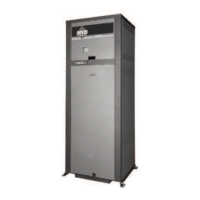
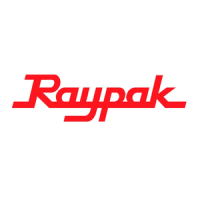




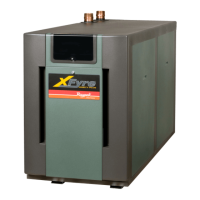
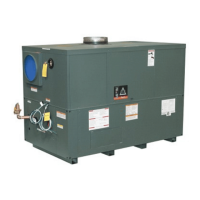
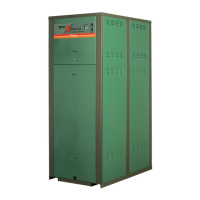
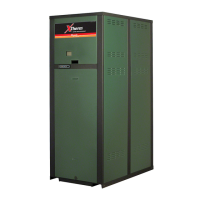
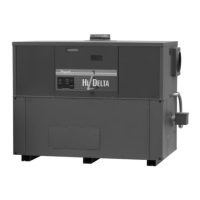
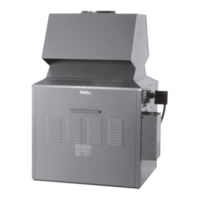
